| Name | Year | Formation | Location | Notes | Images |
|---|
| Abelisaurus | 1985 | Anacleto Formation (Late Cretaceous, Campanian) |  Argentina Argentina | Only known from a single partial skull | 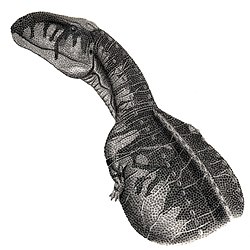 |
| Achillesaurus | 2007 | Bajo de la Carpa Formation (Late Cretaceous, Santonian) |  Argentina Argentina | Potentially a junior synonym of Alvarezsaurus [1] |  |
| Adamantisaurus | 2006 | Adamantina Formation (Late Cretaceous, Turonian to Maastrichtian) |  Brazil Brazil | Derived for a titanosaur as indicated by the ball-and-socket articulations of its caudal vertebrae |  |
| Adeopapposaurus | 2009 | Cañón del Colorado Formation (Early Jurassic, Hettangian to Pliensbachian) |  Argentina Argentina | May have had a keratinous beak based on the shape of its jaw bones | 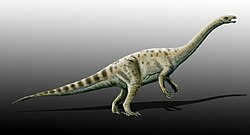 |
| Aeolosaurus | 1987 | Allen Formation?, Angostura Colorada Formation, Lago Colhué Huapí Formation, Los Alamitos Formation?, Serra da Galga Formation? (Late Cretaceous, Campanian to Maastrichtian) |  Argentina Argentina
 Brazil? Brazil? | Known from the remains of several individuals | 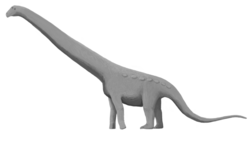 |
| Aerosteon | 2009 | Anacleto Formation (Late Cretaceous, Campanian) |  Argentina Argentina | Its bones were extensively pneumatized, suggesting an air sac system like those of modern birds |  |
| Agustinia | 1999 | Lohan Cura Formation (Early Cretaceous, Aptian to Albian) |  Argentina Argentina | Originally described as possessing long, vaguely stegosaur-like spikes, although these turned out to be fragments of ribs and other bones [2] |  |
| Alnashetri | 2012 | Candeleros Formation (Late Cretaceous, Cenomanian) |  Argentina Argentina | The oldest alvarezsauroid known from South America | 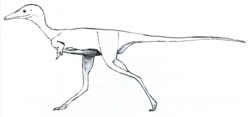 |
| Alvarezsaurus | 1991 | Bajo de la Carpa Formation (Late Cretaceous, Santonian) |  Argentina Argentina | One of the largest known alvarezsaurids |  |
| Amargasaurus | 1991 | La Amarga Formation (Early Cretaceous, Barremian to Aptian) |  Argentina Argentina | Possessed two parallel rows of backward-pointing spines on its neck that may have been covered by keratin sheaths [3] or a skin sail [4] |  |
| Amargatitanis | 2007 | La Amarga Formation (Early Cretaceous, Barremian to Aptian) |  Argentina Argentina | Originally described as a titanosaur [5] although it has since been reinterpreted as a dicraeosaurid [6] |  |
| Amazonsaurus | 2003 | Itapecuru Formation (Early Cretaceous, Aptian to Albian) |  Brazil Brazil | Had tall neural spines on its caudal vertebrae |  |
| Amygdalodon | 1947 | Cerro Carnerero Formation (Early Jurassic, Toarcian) |  Argentina Argentina | Its teeth were shaped like almonds |  |
| Anabisetia | 2002 | Lisandro Formation (Late Cretaceous, Cenomanian to Turonian) |  Argentina Argentina | Four specimens are known but the skull remains incompletely known | 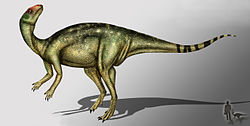 |
| Andesaurus | 1991 | Candeleros Formation (Late Cretaceous, Cenomanian) |  Argentina Argentina | Several osteological features indicate a basal position within the Titanosauria | 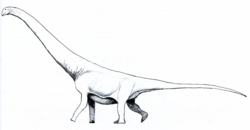 |
| Aniksosaurus | 2006 | Bajo Barreal Formation (Late Cretaceous, Cenomanian to Turonian) |  Argentina Argentina | Bone bed remains suggest a gregarious lifestyle [7] | 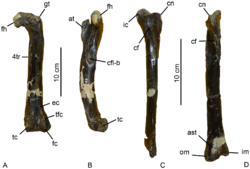 |
| Antarctosaurus | 1929 | Adamantina Formation?, Anacleto Formation, Plottier Formation? (Late Cretaceous, Coniacian? to Campanian) |  Argentina Argentina
 Brazil? Brazil? | Multiple specimens have been assigned to this genus, including some from outside South America, but most may not represent the same taxon |  |
| Anteavis | 2025 | Ischigualasto Formation (Late Triassic, Carnian) |  Argentina Argentina | Has several neotheropod-like features despite not being a member of this clade |  |
| Aoniraptor | 2016 | Huincul Formation (Late Cretaceous, Cenomanian to Turonian) |  Argentina Argentina | Mostly recovered as a megaraptoran [8] but a recent study recovers this genus as a relative of the enigmatic theropod Bahariasaurus [9] |  |
| Arackar | 2021 | Hornitos Formation (Late Cretaceous, Campanian to Maastrichtian) |  Chile Chile | The most complete sauropod known from Chile |  |
| Aratasaurus | 2020 | Romualdo Formation (Early Cretaceous, Aptian) |  Brazil Brazil | All three of its toes were symmetric |  |
| Argentinosaurus | 1993 | Huincul Formation (Late Cretaceous, Cenomanian to Turonian) |  Argentina Argentina | May be the largest known dinosaur |  |
| Argyrosaurus | 1893 | Lago Colhué Huapí Formation (Late Cretaceous, Campanian to Maastrichtian) |  Argentina Argentina | Several remains were historically assigned to this genus, but only the holotype can be confidently assigned to it [10] | 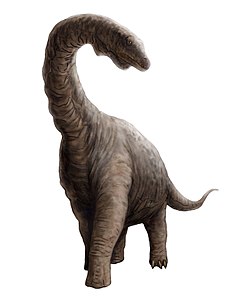 |
| Arrudatitan | 2021 | Adamantina Formation (Late Cretaceous, Campanian to Maastrichtian) |  Brazil Brazil | Its tail probably curved strongly downwards, with the tip held very low to the ground [11] |  |
| Asfaltovenator | 2019 | Cañadón Asfalto Formation (Early Jurassic, Toarcian) |  Argentina Argentina | Combines traits of both megalosauroids and allosauroids. Its describers suggest paraphyly of the former group [12] |  |
| Astigmasaura | 2025 | Huincul Formation (Late Cretaceous, Cenomanian) |  Argentina Argentina | Despite not being complete, the only known skeleton was fully articulated |  |
| Atacamatitan | 2011 | Tolar Formation (Late Cretaceous, Cenomanian to Maastrichtian) |  Chile Chile | Only known from a single, fragmentary skeleton |  |
| Aucasaurus | 2002 | Anacleto Formation (Late Cretaceous, Santonian to Campanian) |  Argentina Argentina | Known from almost the entire skeleton, including most of the skull |  |
| Austrocheirus | 2010 | Cerro Fortaleza Formation (Late Cretaceous, Campanian to Maastrichtian) |  Argentina Argentina | Initially described as an abelisauroid but this has been disputed by subsequent research [13] |  |
| Austroposeidon | 2016 | Presidente Prudente Formation (Late Cretaceous, Campanian to Maastrichtian) |  Brazil Brazil | The largest dinosaur known from Brazil |  |
| Austroraptor | 2008 | Allen Formation (Late Cretaceous, Campanian to Maastrichtian) |  Argentina Argentina | Possessed an elongated snout paralleling that of spinosaurids |  |
| Baalsaurus | 2018 | Portezuelo Formation (Late Cretaceous, Turonian to Coniacian) |  Argentina Argentina | Had a squared-off dentary with its teeth crowded to the front |  |
| Bagualia | 2020 | Cañadón Asfalto Formation (Early Jurassic, Toarcian) |  Argentina Argentina | Represents an early radiation of eusauropods that displaced earlier basal sauropodomorphs after a global warming event [14] |  |
| Bagualosaurus | 2018 | Santa Maria Formation (Late Triassic, Carnian) |  Brazil Brazil | Its hindlimbs were very robust |  |
| Bajadasaurus | 2019 | Bajada Colorada Formation (Early Cretaceous, Berriasian to Valanginian) |  Argentina Argentina | Possessed elongated, forward-pointing spines erupting in pairs from the neck |  |
| Barrosasaurus | 2009 | Anacleto Formation (Late Cretaceous, Campanian) |  Argentina Argentina | Only known from three vertebrae but are well-preserved enough to warrant recognition as a distinct genus |  |
| Baurutitan | 2005 | Serra da Galga Formation (Late Cretaceous, Maastrichtian) |  Brazil Brazil | Originally described from an associated series of nineteen vertebrae. New remains were discovered later [15] |  |
| Berthasaura | 2021 | Goio-Erê Formation (Early Cretaceous, Aptian to Albian) |  Brazil Brazil | Possessed a short, toothless beak, indicating a herbivorous or omnivorous diet |  |
| Bicentenaria | 2012 | Candeleros Formation (Late Cretaceous, Cenomanian) |  Argentina Argentina | Several individuals were preserved together, suggesting a gregarious lifestyle [16] |  |
| Bonapartenykus | 2012 | Allen Formation (Late Cretaceous, Campanian to Maastrichtian) |  Argentina Argentina | Its holotype was preserved with two eggs that may have been within its oviducts when it died [17] |  |
| Bonapartesaurus | 2017 | Allen Formation (Late Cretaceous, Campanian to Maastrichtian) |  Argentina Argentina | Belongs to the Austrokritosauria, a clade of hadrosaurids endemic to South America [18] |  |
| Bonatitan | 2004 | Allen Formation (Late Cretaceous, Campanian to Maastrichtian) |  Argentina Argentina | Analysis of its inner ear suggests a decreased range of head movements compared to other sauropods [19] |  |
| Bonitasaura | 2004 | Bajo de la Carpa Formation (Late Cretaceous, Santonian) |  Argentina Argentina | The proportions of its body were somewhat similar to those of diplodocoids, likely through convergent evolution |  |
| Brachytrachelopan | 2005 | Cañadón Calcáreo Formation (Late Jurassic, Oxfordian to Tithonian) |  Argentina Argentina | Possessed the shortest neck of any known sauropod |  |
| Brasilotitan | 2013 | Adamantina Formation (Late Cretaceous, Maastrichtian) |  Brazil Brazil | Had an L-shaped dentary similar to that of Antarctosaurus and Bonitasaura |  |
| Bravasaurus | 2020 | Ciénaga del Río Huaco Formation (Late Cretaceous, Campanian to Maastrichtian) |  Argentina Argentina | Discovered close to a large concentration of titanosaur eggs |  |
| Buitreraptor | 2005 | Candeleros Formation (Late Cretaceous, Cenomanian to Turonian) |  Argentina Argentina | May have been a pursuit predator due to its long legs [20] |  |
| Buriolestes | 2016 | Santa Maria Formation (Late Triassic, Carnian) |  Brazil Brazil | Unlike all other sauropodomorphs, it was completely carnivorous, with serrated teeth to match |  |
| Bustingorrytitan | 2023 | Huincul Formation (Late Cretaceous, Cenomanian) |  Argentina Argentina | Large yet distantly related to other gigantic titanosaurs [21] |  |
| Caieiria | 2022 | Serra da Galga Formation (Late Cretaceous, Maastrichtian) |  Brazil Brazil | Its caudal vertebrae had an unusual anatomy |  |
| Campananeyen | 2024 | Candeleros Formation (Late Cretaceous, Cenomanian) |  Argentina Argentina | Had a notably pneumatized ilium [22] |  |
| Campylodoniscus | 1961 | Bajo Barreal Formation (Late Cretaceous, Cenomanian) |  Argentina Argentina | Only known from a single maxilla with seven teeth |  |
| Carnotaurus | 1985 | La Colonia Formation (Late Cretaceous, Maastrichtian) |  Argentina Argentina | Possessed a pair of short horns on the top of its skull |  |
| Cathartesaura | 2005 | Huincul Formation (Late Cretaceous, Cenomanian) |  Argentina Argentina | Had a well-muscled neck although it could not move strongly up or down |  |
| Chadititan | 2025 | Anacleto Formation (Late Cretaceous, Campanian) |  Argentina Argentina | Represents a new fossil locality of the Anacleto Formation [23] |  |
| Chakisaurus | 2024 | Huincul Formation (Late Cretaceous, Cenomanian to Turonian) |  Argentina Argentina | Known from various partial skeletons belonging to differently-aged individuals |  |
| Chilesaurus | 2015 | Toqui Formation (Late Jurassic, Tithonian) |  Chile Chile | Combines traits of theropods, sauropodomorphs and ornithischians, with far-reaching implications for the evolution of the Dinosauria |  |
| Choconsaurus | 2017 | Huincul Formation (Late Cretaceous, Cenomanian) |  Argentina Argentina | One of the most completely known basal titanosaurs |  |
| Chromogisaurus | 2010 | Ischigualasto Formation (Late Triassic, Carnian) |  Argentina Argentina | Its discovery suggests that early dinosaurs were more diverse than previously thought |  |
| Chubutisaurus | 1975 | Cerro Barcino Formation (Late Cretaceous, Cenomanian) |  Argentina Argentina | Unusually, its forelimbs were shorter than its hindlimbs [24] | 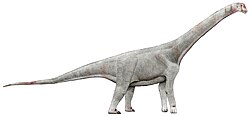 |
| Chucarosaurus | 2023 | Huincul Formation (Late Cretaceous, Cenomanian to Turonian) |  Argentina Argentina | Smaller and more slender than the contemporary Argentinosaurus |  |
| Cienciargentina | 2025 | Huincul Formation (Late Cretaceous, Cenomanian to Turonian) |  Argentina Argentina | The fourth named rebbachisaurid from the Huincul Formation, suggesting a quick faunal turnover for this group |  |
| Clasmodosaurus | 1898 | Cerro Fortaleza Formation, Mata Amarilla Formation (Late Cretaceous, Cenomanian to Maastrichtian) |  Argentina Argentina | Similarly to Bonitasaura , its teeth were polygonal in cross-section | |
| Coloradisaurus | 1990 | Los Colorados Formation (Late Triassic, Norian) |  Argentina Argentina | Originally called Coloradia, although that genus name is preoccupied by a moth |  |
| Comahuesaurus | 2012 | Lohan Cura Formation (Early Cretaceous, Aptian to Albian) |  Argentina Argentina | Its holotype was originally assigned to Limaysaurus , but it was named as a separate genus due to several morphological differences |  |
| Condorraptor | 2005 | Cañadón Asfalto Formation (Early Jurassic, Toarcian) |  Argentina Argentina | Closely related to the coeval Piatnitzkysaurus but could be distinguished by several osteological features |  |
| Diuqin | 2024 | Bajo de la Carpa Formation (Late Cretaceous, Santonian) |  Argentina Argentina | Only known from a humerus and fragmentary vertebrae |  |
| Dreadnoughtus | 2014 | Cerro Fortaleza Formation (Late Cretaceous, Campanian to Maastrichtian) |  Argentina Argentina | The heaviest land animal whose mass can be calculated with reasonable certainty |  |
| Drusilasaura | 2011 | Bajo Barreal Formation (Late Cretaceous, Cenomanian to Turonian) |  Argentina Argentina | Potentially the oldest known member of the lognkosaurian lineage [25] | 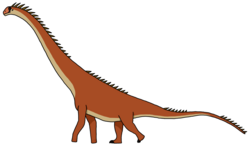 |
| Ekrixinatosaurus | 2004 | Candeleros Formation (Late Cretaceous, Cenomanian) |  Argentina Argentina | Had robust bones, indicating a massive build and a greater resistance to injuries [26] |  |
| Elaltitan | 2012 | Bajo Barreal Formation (Late Cretaceous, Cenomanian to Turonian) |  Argentina Argentina | Extremely large as indicated by its long femur |  |
| Elemgasem | 2022 | Portezuelo Formation (Late Cretaceous, Turonian to Coniacian) |  Argentina Argentina | The first abelisaurid known from the Turonian-Coniacian interval |  |
| Emiliasaura | 2025 | Mulichinco Formation (Early Cretaceous, Valanginian) |  Argentina Argentina | Initially described as a rhabdodontomorph, [27] though a later study instead recovers it as a styracosternan [28] |  |
| Eoabelisaurus | 2012 | Cañadón Asfalto Formation (Early Jurassic, Toarcian) |  Argentina Argentina | Shows a transitional arm morphology for an abelisauroid, with a shortened lower arm and hand, along with an unreduced humerus |  |
| Eodromaeus | 2011 | Ischigualasto Formation (Late Triassic, Carnian) |  Argentina Argentina | Well-adapted for cursoriality despite its early age [29] |  |
| Eoraptor | 1993 | Ischigualasto Formation (Late Triassic, Carnian) |  Argentina Argentina | Possessed different types of teeth, suggesting it was omnivorous |  |
| Epachthosaurus | 1990 | Bajo Barreal Formation (Late Cretaceous, Cenomanian to Turonian) |  Argentina Argentina | Its caudal vertebrae were procoelous, meaning they were concave at the front and convex at the back |  |
| Erythrovenator | 2021 | Candelária Formation (Late Triassic, Carnian to Norian) |  Brazil Brazil | Known from the Riograndia Assemblage Zone, an area which is unusually dominated by cynodonts |  |
| Futalognkosaurus | 2007 | Portezuelo Formation (Late Cretaceous, Coniacian) |  Argentina Argentina | Possessed meter-deep cervical vertebrae with distinctive shark fin-shaped neural spines |  |
| Gasparinisaura | 1996 | Anacleto Formation (Late Cretaceous, Campanian) |  Argentina Argentina | Known from specimens of both adults and juveniles |  |
| Genyodectes | 1901 | Cerro Barcino Formation (Early Cretaceous, Aptian to Albian) |  Argentina Argentina | Had extremely large and protruding teeth |  |
| Giganotosaurus | 1995 | Candeleros Formation (Late Cretaceous, Cenomanian) |  Argentina Argentina | One of the largest known terrestrial carnivorous dinosaurs |  |
| Gnathovorax | 2019 | Santa Maria Formation (Late Triassic, Carnian) |  Brazil Brazil | Known from a well-preserved, almost complete skeleton |  |
| Gondwanatitan | 1999 | Adamantina Formation, Cambabe Formation? (Late Cretaceous, Maastrichtian) |  Brazil Brazil | For a titanosaur, it had relatively gracile limb bones |  |
| Gonkoken | 2023 | Dorotea Formation (Late Cretaceous, Maastrichtian) |  Chile Chile | The southernmost basal hadrosauroid known to date. Known from more southern latitudes than true hadrosaurids |  |
| Guaibasaurus | 1999 | Caturrita Formation (Late Triassic, Norian) |  Brazil Brazil | Combines features of both early theropods and sauropodomorphs |  |
| Gualicho | 2016 | Huincul Formation (Late Cretaceous, Cenomanian to Turonian) |  Argentina Argentina | Originally described as having highly reduced arms with only two fingers, convergent with tyrannosaurids, although one study suggests that a third finger was present [30] |  |
| Guemesia | 2022 | Los Blanquitos Formation (Late Cretaceous, Campanian) |  Argentina Argentina | Unlike other abelisaurids, it lacked any ornamentation on its skull [31] | 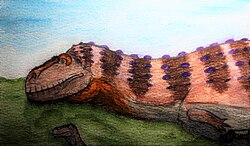 |
| Herrerasaurus | 1963 | Ischigualasto Formation (Late Triassic, Carnian) |  Argentina Argentina | One of the largest early carnivorous dinosaurs. Usually considered a basal saurischian but may be just outside the Dinosauria [32] |  |
| Huallasaurus | 2022 | Los Alamitos Formation (Late Cretaceous, Campanian to Maastrichtian) |  Argentina Argentina | Remains originally misidentified as belonging to a southern species of Kritosaurus |  |
| Huayracursor | 2025 | Santo Domingo Formation (Late Triassic, Carnian) |  Argentina Argentina | Larger and longer-necked than more basal sauropodomorphs. Closely related to Bagualosaurus [33] |  |
| Huinculsaurus | 2020 | Huincul Formation (Late Cretaceous, Cenomanian to Turonian) |  Argentina Argentina | The youngest known elaphrosaurine |  |
| Ibirania | 2022 | São José do Rio Preto Formation (Late Cretaceous, Santonian to Campanian) |  Brazil Brazil | May have attained its small size due to its arid inland habitat, unlike other dwarf titanosaurs which were affected by insular dwarfism [34] |  |
| Ilokelesia | 1998 | Huincul Formation (Late Cretaceous, Cenomanian) |  Argentina Argentina | Its skull retains some basal abelisauroid traits |  |
| Inawentu | 2024 | Bajo de la Carpa Formation (Late Cretaceous, Santonian) |  Argentina Argentina | Possessed a short neck and squared-off snout, convergent with the rebbachisaurids that went extinct shortly before this genus lived |  |
| Ingentia | 2018 | Quebrada del Barro Formation (Late Triassic, Norian to Rhaetian) |  Argentina Argentina | One of the earliest known very large sauropodomorphs [35] |  |
| Irritator | 1996 | Romualdo Formation (Early Cretaceous, Albian) |  Brazil Brazil | May have been the apex predator of its habitat, hunting both aquatic and terrestrial prey [36] | 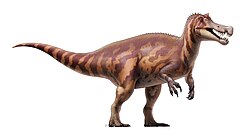 |
| Isaberrysaura | 2017 | Los Molles Formation (Middle Jurassic, Bajocian) |  Argentina Argentina | Preserves gut contents including whole seeds |  |
| Isasicursor | 2019 | Chorrillo Formation (Late Cretaceous, Maastrichtian) |  Argentina Argentina | Four individuals of different ages were found together, suggesting it lived in herds [37] |  |
| Itapeuasaurus | 2019 | Alcântara Formation (Late Cretaceous, Cenomanian) |  Brazil Brazil | The holotype is known from six vertebrae |  |
| Jakapil | 2022 | Candeleros Formation (Late Cretaceous, Cenomanian) |  Argentina Argentina | May represent a novel lineage of ornithischians characterized by small size, deep jaws and a bipedal stance |  |
| Joaquinraptor | 2025 | Lago Colhué Huapí Formation (Late Cretaceous, Maastrichtian) |  Argentina Argentina | May have preyed upon crocodyliforms as suggested by the associated remains of one [38] |  |
| Kaijutitan | 2019 | Sierra Barrosa Formation (Late Cretaceous, Coniacian) |  Argentina Argentina | One of the latest-surviving basal titanosaurs | |
| Katepensaurus | 2013 | Bajo Barreal Formation (Late Cretaceous, Cenomanian to Turonian) |  Argentina Argentina | Distinguished by a certain opening in its dorsal vertebrae |  |
| Kelumapusaura | 2022 | Allen Formation (Late Cretaceous, Campanian to Maastrichtian) |  Argentina Argentina | Known from the remains of various individuals |  |
| Koleken | 2024 | La Colonia Formation (Late Cretaceous, Maastrichtian) |  Argentina Argentina | Contemporary with its larger relative Carnotaurus |  |
| Kurupi | 2021 | Marília Formation (Late Cretaceous, Maastrichtian) |  Brazil Brazil | Would have had a stiff tail as indicated by the anatomy of its caudal vertebrae |  |
| Lajasvenator | 2020 | Mulichinco Formation (Early Cretaceous, Valanginian) |  Argentina Argentina | One of the smallest known allosauroids |  |
| Lapampasaurus | 2012 | Allen Formation (Late Cretaceous, Campanian to Maastrichtian) |  Argentina Argentina | Known from a partial skeleton lacking the skull | |
| Laplatasaurus | 1929 | Anacleto Formation (Late Cretaceous, Campanian) |  Argentina Argentina | Osteoderms have been assigned to this taxon although this referral is uncertain |  |
| Laquintasaura | 2014 | La Quinta Formation (Early Jurassic, Hettangian) |  Venezuela Venezuela | One study recovered it as a basal thyreophoran [39] despite the fact no osteoderms have been found |  |
| Lavocatisaurus | 2018 | Rayoso Formation (Early Cretaceous, Aptian to Albian) |  Argentina Argentina | May have possessed a keratinous beak [40] |  |
| Leinkupal | 2014 | Bajada Colorada Formation (Early Cretaceous, Berriasian to Valanginian) |  Argentina Argentina | The youngest known diplodocid |  |
| Leonerasaurus | 2011 | Las Leoneras Formation (Early Jurassic, Sinemurian to Toarcian) |  Argentina Argentina | Has an unusual combination of basal and derived traits | 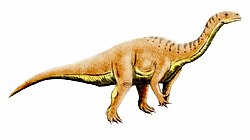 |
| Lessemsaurus | 1999 | Los Colorados Formation (Late Triassic, Norian) |  Argentina Argentina | Grew very large despite lacking the anatomical traits usually seen as a support for gigantism [35] |  |
| Leyesaurus | 2011 | Quebrada del Barro Formation (Early Jurassic, Hettangian to Toarcian) |  Argentina Argentina | Had an unusually small skull |  |
| Ligabueino | 1996 | La Amarga Formation (Early Cretaceous, Barremian to Aptian) |  Argentina Argentina | Known from a single, very small skeleton belonging to a juvenile animal | |
| Ligabuesaurus | 2006 | Lohan Cura Formation (Early Cretaceous, Aptian to Albian) |  Argentina Argentina | Its forelimbs were extremely long, with similar proportions to those of brachiosaurids [41] |  |
| Limaysaurus | 2004 | Candeleros Formation, Huincul Formation (Late Cretaceous, Cenomanian) |  Argentina Argentina | Possessed elongated neural spines on its dorsal vertebrae |  |
| Llukalkan | 2021 | Bajo de la Carpa Formation (Late Cretaceous, Santonian) |  Argentina Argentina | May have had a keen sense of hearing due to the shape of its ear [42] | |
| Loncosaurus | 1899 | Cardiel Formation, Metasiete Formation? (Late Cretaceous, Campanian to Maastrichtian) |  Argentina Argentina | Poorly known | |
| Loricosaurus | 1929 | Allen Formation (Late Cretaceous, Maastrichtian) |  Argentina Argentina | Potentially synonymous with Neuquensaurus or Saltasaurus | |
| Lucianovenator | 2017 | Quebrada del Barro Formation (Late Triassic, Norian to Rhaetian) |  Argentina Argentina | One of the few theropods known from the Rhaetian |  |
| Macrocollum | 2018 | Candelária Formation (Late Triassic, Norian) |  Brazil Brazil | One of the oldest sauropodomorphs with an extremely elongated neck | 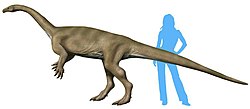 |
| Macrogryphosaurus | 2007 | Sierra Barrosa Formation (Late Cretaceous, Coniacian) |  Argentina Argentina | Preserves a series of mineralized plates along the side of the torso |  |
| Mahuidacursor | 2019 | Bajo de la Carpa Formation (Late Cretaceous, Santonian) |  Argentina Argentina | Its holotype was sexually mature but not fully grown | |
| Maip | 2022 | Chorrillo Formation (Late Cretaceous, Maastrichtian) |  Argentina Argentina | The largest known megaraptoran |  |
| Malarguesaurus | 2008 | Portezuelo Formation (Late Cretaceous, Turonian to Coniacian) |  Argentina Argentina | Large and robustly built | |
| Manidens | 2011 | Cañadón Asfalto Formation (Early Jurassic, Toarcian) |  Argentina Argentina | May have been arboreal due to the structure of its feet, with toes adapted for grasping [43] |  |
| Mapusaurus | 2006 | Huincul Formation (Late Cretaceous, Cenomanian to Turonian) |  Argentina Argentina | At least seven specimens of different growth stages are known, possibly suggesting that this taxon lived and/or hunted in packs |  |
| Maxakalisaurus | 2006 | Adamantina Formation (Late Cretaceous, Maastrichtian) |  Brazil Brazil | Unusually for a sauropod, it had ridged teeth |  |
| Megaraptor | 1998 | Portezuelo Formation (Late Cretaceous, Turonian to Coniacian) |  Argentina Argentina | Possessed a large, strongly curved claw on its first finger |  |
| Mendozasaurus | 2003 | Sierra Barrosa Formation (Late Cretaceous, Coniacian) |  Argentina Argentina | Had spherical osteoderms that were probably located in rows along the flanks [44] |  |
| Menucocelsior | 2022 | Allen Formation (Late Cretaceous, Maastrichtian) |  Argentina Argentina | Coexisted with multiple other titanosaurs that may have niche-partitioned [45] | |
| Meraxes | 2022 | Huincul Formation (Late Cretaceous, Cenomanian) |  Argentina Argentina | Possessed reduced forelimbs convergent with several other groups of theropods |  |
| Microcoelus | 1893 | Bajo de la Carpa Formation (Late Cretaceous, Santonian) |  Argentina Argentina | May be a synonym of Neuquensaurus |  |
| Mirischia | 2004 | Romualdo Formation (Early Cretaceous, Albian) |  Brazil Brazil | Its holotype preserves an intestine |  |
| Murusraptor | 2016 | Sierra Barrosa Formation (Late Cretaceous, Coniacian) |  Argentina Argentina | Had a brain morphology similar to that of tyrannosaurids but its sensory capabilities were closer to the level of allosauroids [46] |  |
| Mussaurus | 1979 | Laguna Colorada Formation (Early Jurassic, Sinemurian) |  Argentina Argentina | Multiple specimens from different growth stages are known. Juveniles may have been quadrupedal and shifted to bipedality as adults [47] |  |
| Muyelensaurus | 2007 | Plottier Formation (Late Cretaceous, Coniacian to Santonian) |  Argentina Argentina | Relatively gracile for a titanosaur | |
| Narambuenatitan | 2011 | Anacleto Formation (Late Cretaceous, Campanian) |  Argentina Argentina | Its neural spines are very similar to those of Epachthosaurus |  |
| Neuquenraptor | 2005 | Portezuelo Formation (Late Cretaceous, Coniacian) |  Argentina Argentina | Potentially synonymous with Unenlagia [48] |  |
| Neuquensaurus | 1992 | Anacleto Formation (Late Cretaceous, Campanian) |  Argentina Argentina | One of the smallest known titanosaurs |  |
| Nhandumirim | 2019 | Santa Maria Formation (Late Triassic, Carnian) |  Brazil Brazil | Originally described as a theropod [49] but has since been reinterpreted as a sauropodomorph [50] |  |
| Niebla | 2020 | Allen Formation (Late Cretaceous, Campanian to Maastrichtian) |  Argentina Argentina | Had a uniquely built scapulocoracoid very similar to that of Carnotaurus |  |
| Ninjatitan | 2021 | Bajada Colorada Formation (Early Cretaceous, Berriasian to Valanginian) |  Argentina Argentina | The oldest known titanosaur | |
| Noasaurus | 1980 | Lecho Formation (Late Cretaceous, Campanian to Maastrichtian) |  Argentina Argentina | Originally mistakenly believed to have possessed a dromaeosaurid-like sickle claw |  |
| Nopcsaspondylus | 2007 | Candeleros Formation (Late Cretaceous, Cenomanian) |  Argentina Argentina | Named from a single, lost vertebra |  |
| Notoceratops | 1918 | Lago Colhué Huapí Formation (Late Cretaceous, Campanian to Maastrichtian) |  Argentina Argentina | Originally described as a ceratopsian but this identity is today doubted | 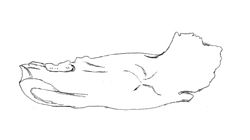 |
| Notocolossus | 2016 | Plottier Formation (Late Cretaceous, Coniacian to Santonian) |  Argentina Argentina | Unusually for a sauropod, its unguals were truncated |  |
| Notohypsilophodon | 1998 | Bajo Barreal Formation (Late Cretaceous, Cenomanian to Turonian) |  Argentina Argentina | Only known from a juvenile skeleton without the skull |  |
| Nullotitan | 2019 | Chorrillo Formation (Late Cretaceous, Campanian to Maastrichtian) |  Argentina Argentina | Would have niche-partitioned with smaller ornithopods |  |
| Orkoraptor | 2008 | Cerro Fortaleza Formation (Late Cretaceous, Campanian) |  Argentina Argentina | Had highly specialized dentition similar to that of coelurosaurs |  |
| Overoraptor | 2020 | Huincul Formation (Late Cretaceous, Cenomanian to Turonian) |  Argentina Argentina | Shows adaptations for both flight and cursoriality |  |
| Overosaurus | 2013 | Bajo de la Carpa Formation (Late Cretaceous, Santonian) |  Argentina Argentina | One of the smallest known aeolosaurins |  |
| Padillasaurus | 2015 | Paja Formation (Early Cretaceous, Barremian) |  Colombia Colombia | Originally described as a brachiosaurid [51] although it could also be a somphospondylian [52] | 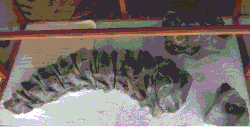 |
| Pampadromaeus | 2011 | Santa Maria Formation (Late Triassic, Carnian) |  Brazil Brazil | Some features of its jaws are similar to those of theropods |  |
| Pamparaptor | 2011 | Portezuelo Formation (Late Cretaceous, Turonian to Coniacian) |  Argentina Argentina | Had a troodontid-like metatarsal |  |
| Panamericansaurus | 2010 | Allen Formation (Late Cretaceous, Campanian to Maastrichtian) |  Argentina Argentina | Known from a single partial skeleton | |
| Pandoravenator | 2017 | Cañadón Calcáreo Formation (Late Jurassic, Oxfordian to Tithonian) |  Argentina Argentina | Inconsistent in phylogenetic placement | |
| Panphagia | 2009 | Ischigualasto Formation (Late Triassic, Carnian) |  Argentina Argentina | Was omnivorous as indicated by its heterodont dentition |  |
| Patagonykus | 1996 | Portezuelo Formation (Late Cretaceous, Turonian to Coniacian) |  Argentina Argentina | Its discovery allowed researchers to connect Alvarezsaurus to parvicursorines [53] |  |
| Patagopelta | 2022 | Allen Formation (Late Cretaceous, Campanian to Maastrichtian) |  Argentina Argentina | Although originally described as a nodosaurid, later analyses recover it as a parankylosaurian [54] |  |
| Patagosaurus | 1979 | Cañadón Asfalto Formation (Early Jurassic, Toarcian) |  Argentina Argentina | Known from remains of adults and juveniles, depicting how various features developed in sauropods as they aged |  |
| Patagotitan | 2017 | Cerro Barcino Formation (Early Cretaceous, Albian) |  Argentina Argentina | One of the largest dinosaurs known from reasonably complete remains | 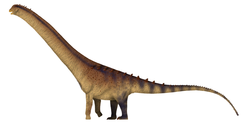 |
| Pellegrinisaurus | 1996 | Allen Formation (Late Cretaceous, Campanian to Maastrichtian) |  Argentina Argentina | May have lived inland unlike other contemporaneous titanosaurs [55] |  |
| Perijasaurus | 2022 | La Quinta Formation (Early Jurassic to Middle Jurassic, Toarcian to Aalenian) |  Colombia Colombia | Only known from a single vertebra |  |
| Petrobrasaurus | 2011 | Plottier Formation (Late Cretaceous, Coniacian to Santonian) |  Argentina Argentina | Shares somes features with lognkosaurs, but its membership within this clade cannot be confirmed |  |
| Piatnitzkysaurus | 1979 | Cañadón Asfalto Formation (Early Jurassic, Toarcian) |  Argentina Argentina | One of the few early theropods with a well-preserved braincase |  |
| Pilmatueia | 2019 | Mulichinco Formation (Early Cretaceous, Valanginian) |  Argentina Argentina | Had elongated spines on its cervical vertebrae, although they were not as tall as those of Amargasaurus and Bajadasaurus [56] |  |
| Pitekunsaurus | 2008 | Anacleto Formation (Late Cretaceous, Campanian) |  Argentina Argentina | Known from several bones from different parts of the body, including a braincase |  |
| Powellvenator | 2017 | Los Colorados Formation (Late Triassic, Norian) |  Argentina Argentina | Some of this genus' remains were originally associated with those of a pseudosuchian [57] | |
| Puertasaurus | 2005 | Cerro Fortaleza Formation (Late Cretaceous, Campanian to Maastrichtian) |  Argentina Argentina | Large but only known from very few remains |  |
| Punatitan | 2020 | Ciénaga del Río Huaco Formation (Late Cretaceous, Campanian to Maastrichtian) |  Argentina Argentina | Contemporary with Bravasaurus but was most likely distantly related [58] | |
| Pycnonemosaurus | 2002 | Cachoeira do Bom Jardim Formation (Late Cretaceous, Campanian to Maastrichtian) |  Brazil Brazil | Potentially the largest known abelisaurid [59] |  |
| Quetecsaurus | 2014 | Lisandro Formation (Late Cretaceous, Turonian) |  Argentina Argentina | Its humerus has a unique shape |  |
| Quilmesaurus | 2001 | Allen Formation (Late Cretaceous, Campanian to Maastrichtian) |  Argentina Argentina | Had proportionally robust legs despite its small size |  |
| Rayososaurus | 1996 | Candeleros Formation (Late Cretaceous, Cenomanian) |  Argentina Argentina | Very similar to Rebbachisaurus despite being only known from scant remains |  |
| Rinconsaurus | 2003 | Bajo de la Carpa Formation (Late Cretaceous, Santonian) |  Argentina Argentina | Unusually, its caudal vertebrae had a repeating pattern of procoely, amphicoely, opisthocoely and biconvex states |  |
| Riojasaurus | 1969 | Los Colorados Formation (Late Triassic, Norian) |  Argentina Argentina | Although commonly depicted as quadrupedal, the structure of its shoulder girdle suggests it may have potentially been bipedal |  |
| Rocasaurus | 2000 | Allen Formation (Late Cretaceous, Campanian to Maastrichtian) |  Argentina Argentina | Small for a sauropod yet was very robust |  |
| Saltasaurus | 1980 | Lecho Formation (Late Cretaceous, Maastrichtian) |  Argentina Argentina | Possessed osteoderms in the form of large round nodules connected by a mass of smaller plates |  |
| Sanjuansaurus | 2010 | Ischigualasto Formation (Late Triassic, Carnian) |  Argentina Argentina | Coexisted with Herrerasaurus but most likely represents a separate taxon |  |
| Santanaraptor | 1999 | Romualdo Formation (Early Cretaceous, Aptian to Albian) |  Brazil Brazil | Preserves soft tissues including the remains of skin, muscle and possibly blood vessels [60] [61] |  |
| Sarmientosaurus | 2016 | Bajo Barreal Formation (Late Cretaceous, Cenomanian to Turonian) |  Argentina Argentina | Analysis of its inner ear suggests it held its head downwards, possibly indicating a preference for low-growing plants |  |
| Saturnalia | 1999 | Santa Maria Formation (Late Triassic, Carnian) |  Brazil Brazil | Known from at least three partial skeletons |  |
| Secernosaurus | 1979 | Lago Colhué Huapí Formation (Late Cretaceous, Maastrichtian) |  Argentina Argentina | Would have lived in an arid gypsum desert [62] |  |
| Sektensaurus | 2019 | Lago Colhué Huapí Formation (Late Cretaceous, Campanian) |  Argentina Argentina | The first non-hadrosaurid ornithopod recovered from central Patagonia | |
| Sidersaura | 2024 | Huincul Formation (Late Cretaceous, Cenomanian to Turonian) |  Argentina Argentina | One of the largest known rebbachisaurids |  |
| Skorpiovenator | 2009 | Huincul Formation (Late Cretaceous, Cenomanian to Turonian) |  Argentina Argentina | Had an unusually short, deep skull |  |
| Spectrovenator | 2020 | Quiricó Formation (Early Cretaceous, Barremian to Aptian) |  Brazil Brazil | Its holotype was found underneath a sauropod skeleton |  |
| Staurikosaurus | 1970 | Santa Maria Formation (Late Triassic, Carnian) |  Brazil Brazil | May have been a rare component of its environment as only two specimens are known |  |
| Stegouros | 2021 | Dorotea Formation (Late Cretaceous, Campanian to Maastrichtian) |  Chile Chile | Possessed a "macuahuitl" at the end of its tail, made of a connected "frond" of pointed osteoderms |  |
| Tachiraptor | 2014 | La Quinta Formation (Early Jurassic, Hettangian) |  Venezuela Venezuela | Closely related to ceratosaurs and tetanurans [63] |  |
| Talenkauen | 2004 | Cerro Fortaleza Formation (Late Cretaceous, Campanian to Maastrichtian) |  Argentina Argentina | May have practiced parental care as an adult and a hatchling have been found together |  |
| Tapuiasaurus | 2011 | Quiricó Formation (Early Cretaceous, Aptian) |  Brazil Brazil | One of the few titanosaurs from which a complete skull is known |  |
| Taurovenator | 2016 | Huincul Formation (Late Cretaceous, Cenomanian) |  Argentina Argentina | Originally known from a single postorbital. Additional remains were described in 2024 [64] |  |
| Tehuelchesaurus | 1999 | Cañadón Calcáreo Formation (Late Jurassic, Oxfordian to Tithonian) |  Argentina Argentina | Preserves impressions of scaly skin |  |
| Thanos | 2020 | São José do Rio Preto Formation (Late Cretaceous, Santonian) |  Brazil Brazil | Only known from a single vertebra. The generic name honors the Marvel Comics villain Thanos |  |
| Tiamat | 2024 | Açu Formation (Early Cretaceous to Late Cretaceous, Albian to Cenomanian) |  Brazil Brazil | Named after a Mesopotamian goddess |  |
| Tietasaura | 2024 | Marfim Formation (Early Cretaceous, Valanginian to Hauterivian) |  Brazil Brazil | The first unambiguous ornithischian genus described from Brazil [65] |  |
| Titanomachya | 2024 | La Colonia Formation (Late Cretaceous, Maastrichtian) |  Argentina Argentina | The morphology of its astragalus is intermediate between members of the Colossosauria and Saltasauroidea [66] |  |
| Tralkasaurus | 2020 | Huincul Formation (Late Cretaceous, Cenomanian to Turonian) |  Argentina Argentina | Exhibits a conflicting blend of characteristics from basal and derived abelisauroids | |
| Tratayenia | 2018 | Bajo de la Carpa Formation (Late Cretaceous, Santonian) |  Argentina Argentina | One of the youngest known megaraptorans [67] |  |
| Traukutitan | 2011 | Bajo de la Carpa Formation (Late Cretaceous, Santonian) |  Argentina Argentina | Retained basal features in its caudal vertebrae despite its late age | |
| Trigonosaurus | 2005 | Serra da Galga Formation (Late Cretaceous, Maastrichtian) |  Brazil Brazil | Potentially synonymous with Baurutitan [15] |  |
| Triunfosaurus | 2017 | Rio Piranhas Formation (Early Cretaceous, Berriasian to Valanginian) |  Brazil Brazil | Originally described as a titanosaur [68] but similarities have been noted with basal somphospondylians [69] | |
| Tyrannotitan | 2005 | Cerro Barcino Formation (Early Cretaceous, Albian) |  Argentina Argentina | Unlike other carcharodontosaurids, its sacral and caudal vertebrae were not pneumatic |  |
| Uberabatitan | 2008 | Serra da Galga Formation (Late Cretaceous, Maastrichtian) |  Brazil Brazil | Several individuals are known, some of which are very large | 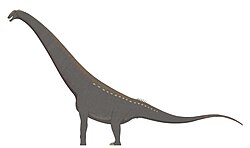 |
| Udelartitan | 2024 | Guichón Formation (Late Cretaceous, Cenomanian to Santonian) |  Uruguay Uruguay | Known from at least two fragmentary specimens |  |
| Unaysaurus | 2004 | Caturrita Formation (Late Triassic, Carnian to Norian) |  Brazil Brazil | Described as the first plateosaurid-grade sauropodomorph from Brazil |  |
| Unenlagia | 1997 | Portezuelo Formation (Late Cretaceous, Coniacian) |  Argentina Argentina | Could potentially be adapted for flapping due to the structure of its shoulder girdle [70] |  |
| Unquillosaurus | 1979 | Los Blanquitos Formation (Late Cretaceous, Maastrichtian) |  Argentina Argentina | Has been suggested to be a dromaeosaurid [71] or a carcharodontosaurid [72] | |
| Velocisaurus | 1991 | Bajo de la Carpa Formation (Late Cretaceous, Santonian) |  Argentina Argentina | Unusually, its third metatarsal is the thickest, which may be an adaptation to running |  |
| Vespersaurus | 2019 | Rio Paraná Formation (Early Cretaceous to Late Cretaceous, Aptian to Campanian) |  Brazil Brazil | Possessed raised claws on its second and fourth toes, making it functionally monodactyl, a possible adaptation to its desert habitat |  |
| Viavenator | 2016 | Bajo de la Carpa Formation (Late Cretaceous, Santonian) |  Argentina Argentina | May have relied on quick movements of its head and gaze stabilization when hunting |  |
| Vitosaura | 2025 | Los Llanos Formation (Late Cretaceous, Campanian) |  Argentina Argentina | One of the few Argentinian ceratosaurs discovered outside of Patagonia |  |
| Volkheimeria | 1979 | Cañadón Asfalto Formation (Early Jurassic, Toarcian) |  Argentina Argentina | Coexisted with at least four other eusauropods | |
| Willinakaqe | 2010 | Allen Formation (Late Cretaceous, Campanian to Maastrichtian) |  Argentina Argentina | As originally described, it represented a chimera of two different taxa, one of which was later named Bonapartesaurus [73] |  |
| Xenotarsosaurus | 1986 | Bajo Barreal Formation (Late Cretaceous, Cenomanian to Turonian) |  Argentina Argentina | Its astragalus and calcaneum had an unusual shape |  |
| Yamanasaurus | 2019 | Río Playas Formation (Late Cretaceous, Campanian to Maastrichtian) |  Ecuador Ecuador | The northernmost saltasaurine known to date [58] |  |
| Ypupiara | 2021 | Serra da Galga Formation (Late Cretaceous, Maastrichtian) |  Brazil Brazil | May have been a piscivore due to the shape of its teeth [74] |  |
| Zapalasaurus | 2006 | La Amarga Formation (Early Cretaceous, Hauterivian to Aptian) |  Argentina Argentina | Known from an incomplete skeleton, including several caudal vertebrae |  |
| Zupaysaurus | 2003 | Los Colorados Formation (Late Triassic, Norian) |  Argentina Argentina | Although commonly depicted with head crests, they may in fact be misplaced lacrimal bones [75] | 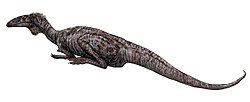 |












































































































































































































